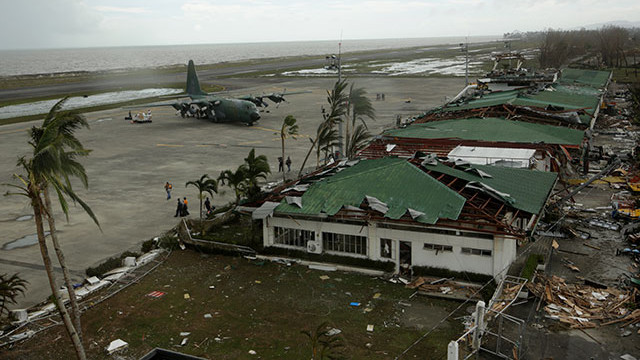SUMMARY
This is AI generated summarization, which may have errors. For context, always refer to the full article.

MANILA, Philippines – No wonder it was the worst hit by Super Typhoon Yolanda (international name: Haiyan). Tacloban City was deemed the most vulnerable to climate change among 4 Philippine cities assessed by a new study.
From a range of 1 to 10 – with 10 being most vulnerable – Tacloban was rated 6.74 in terms of how exposed it is to climate change impacts, like stronger storms, extreme droughts, sea level rise, and aggravated flooding and landslides.
The study, conducted by Worldwide Fund for Nature (WWF) Philippines and BPI Foundation, gave this score based on 3 factors: climate or environmental exposure, socio-economic sensitivity, and capacity to adapt.
Climate or environmental exposure
Tacloban’s location on the country’s eastern seaboard exposes it to many climate risks, like tropical cyclones during the southwest monsoon.
Even before Typhoon Yolanda hit the city on Nov 8, 2013, Tacloban was already feeling the effects of a shifting climate.
Records show that from 1998 to 2011, there was a 257% increase in rainfall, from 1,853 mm to 4,768 mm. Over a 50-year period, the city has been hit by an average of 2.3 typhoons a year. No wonder more flooding has been reported by residents.
Geohazard maps of the city also show high susceptibility to landslides, particularly for its upland villages. Being only 3 meters above sea level, Tacloban is also threatened by sea level rise. Studies show that seas can rise by 4 to 6 meters due to climate change.
For these reasons, Tacloban is said to be within the jaws of a “climate sandwich.”
Socio-economic sensitivity
Tacloban is a growing city.
Over 20 years, its population has risen by 62% from around 136,000 in 1990 to around 221,000 in 2010. More houses have been built (74% more in less than two decades), more cars are on the road (312% increase in 20 years).
The more people in a city, the more vulnerable to climate change the city is.
Tacloban’s economy is tied to its port. Domestic cargo is a growing business, with volumes increasing by 63% from 2008 to 2012.
Its airport is also a major source of economic growth. Spurred by airline promos, air passengers to and from Tacloban almost doubled from 2000 to 2011.
Its fishing industry is an important economic contributor. Municipal fisheries reported a 63% increase in catch while aquaculture production has tripled. Ocean acidification, or the change in Ph levels of sea waters, can threaten fish supply. The climate change-related phenomenon can kill coral reefs and impair the development of some marine species.
Adaptive capacity
How capable is Tacloban of getting back on its feet after a severe storm or another climate-related event?
Citizens appear to have enough resources to recover, at least partially, whatever losses they incur. Average annual savings rose from just P4,000 in 1991 to P32,000 in 2009. The number of bank accounts also increased by 30%.
But the city government is not so lucky. City savings dropped from around P120,000 in 2002 to P83,000 in 2011.
Recommendations
Given its susceptibility to flooding and sea level rise, Tacloban should upgrade its drainage system. It should also manage its upland communities, which are threatened by landslides.
But Tacloban can turn increasing rainfall into an opportunity instead of a problem. The study recommends that the city impound rainwater for urban and agricultural use. This would solve its current water supply and water quality problem.
Being dependent on air passengers for its growing economy, Tacloban should rethink the location of its single airport. Putting seawalls may not be enough.
***
Tacloban is one of 4 cities assessed by the study. The others are Naga City in Camarines Sur, Batangas City in Batangas, and Angeles City in Pampanga. Previous phases assessed 8 other cities. Download the studies for all 12 cities from this site. – Rappler.com
Add a comment
How does this make you feel?
There are no comments yet. Add your comment to start the conversation.